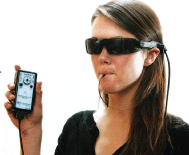A new device allows blind people to see with their tongues. The BrainPort, by Wicab, consists of a camera worn on a pair of sunglasses, a sensor that the user places on his or her tongue (the intra-oral device, or IOD) and a hand-held controller. The camera sees an object, and the IOD draws it on the user's tongue with small electric pulses.
 Patients who use the device can, with practice, detect shapes and location. "You feel a sensation--a shape--on your tongue," says principal investigator Amy Nau, O.D., of the
Patients who use the device can, with practice, detect shapes and location. "You feel a sensation--a shape--on your tongue," says principal investigator Amy Nau, O.D., of the
The specificity of the IOD is limited by the fact that the tongue can only differentiate down to 0.5mm. "I liken it to walking around your house in the dark [as a sighted person]," says Dr. Nau. "You don't have all the visual information that's there, but you have the big pieces."
One planned future study will allow patients to take the device home for six months to test extended usage applications, and another will test the possible implementation of machine vision technologies, such as facial recognition software.

